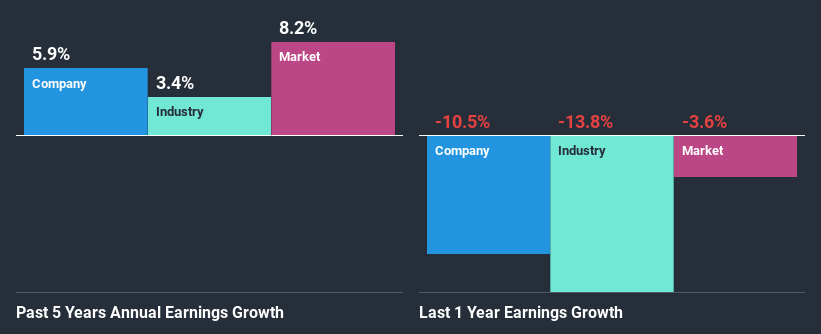Port of Tauranga Limited's (NZSE:POT) Stock Has Shown A Decent Performance: Have Financials A Role To Play?

Most readers would already know that Port of Tauranga's (NZSE:POT) stock increased by 4.0% over the past month. Given that stock prices are usually aligned with a company's financial performance in the long-term, we decided to investigate if the company's decent financials had a hand to play in the recent price move. Specifically, we decided to study Port of Tauranga's ROE in this article.
Return on equity or ROE is an important factor to be considered by a shareholder because it tells them how effectively their capital is being reinvested. In other words, it is a profitability ratio which measures the rate of return on the capital provided by the company's shareholders.
Check out our latest analysis for Port of Tauranga
How To Calculate Return On Equity?
ROE can be calculated by using the formula:
Return on Equity = Net Profit (from continuing operations) ÷ Shareholders' Equity
So, based on the above formula, the ROE for Port of Tauranga is:
7.7% = NZ$90m ÷ NZ$1.2b (Based on the trailing twelve months to June 2020).
The 'return' refers to a company's earnings over the last year. So, this means that for every NZ$1 of its shareholder's investments, the company generates a profit of NZ$0.08.
What Has ROE Got To Do With Earnings Growth?
So far, we've learned that ROE is a measure of a company's profitability. Depending on how much of these profits the company reinvests or "retains", and how effectively it does so, we are then able to assess a company’s earnings growth potential. Assuming all else is equal, companies that have both a higher return on equity and higher profit retention are usually the ones that have a higher growth rate when compared to companies that don't have the same features.
Port of Tauranga's Earnings Growth And 7.7% ROE
At first glance, Port of Tauranga's ROE doesn't look very promising. Although a closer study shows that the company's ROE is higher than the industry average of 4.9% which we definitely can't overlook. This certainly adds some context to Port of Tauranga's moderate 5.9% net income growth seen over the past five years. That being said, the company does have a slightly low ROE to begin with, just that it is higher than the industry average. So there might well be other reasons for the earnings to grow. For example, it is possible that the broader industry is going through a high growth phase, or that the company has a low payout ratio.
We then compared Port of Tauranga's net income growth with the industry and we're pleased to see that the company's growth figure is higher when compared with the industry which has a growth rate of 3.4% in the same period.
The basis for attaching value to a company is, to a great extent, tied to its earnings growth. The investor should try to establish if the expected growth or decline in earnings, whichever the case may be, is priced in. This then helps them determine if the stock is placed for a bright or bleak future. If you're wondering about Port of Tauranga's's valuation, check out this gauge of its price-to-earnings ratio, as compared to its industry.
Is Port of Tauranga Making Efficient Use Of Its Profits?
The high three-year median payout ratio of 90% (or a retention ratio of 10.0%) for Port of Tauranga suggests that the company's growth wasn't really hampered despite it returning most of its income to its shareholders.
Moreover, Port of Tauranga is determined to keep sharing its profits with shareholders which we infer from its long history of paying a dividend for at least ten years. Based on the latest analysts' estimates, we found that the company's future payout ratio over the next three years is expected to hold steady at 88%. Still, forecasts suggest that Port of Tauranga's future ROE will rise to 9.9% even though the the company's payout ratio is not expected to change by much.
Conclusion
In total, it does look like Port of Tauranga has some positive aspects to its business. Especially the growth in earnings which was backed by a moderate ROE. Still, the ROE could have been even more beneficial to investors had the company been reinvesting more of its profits. As highlighted earlier, the current reinvestment rate appears to be negligible. Having said that, looking at the current analyst estimates, we found that the company's earnings are expected to gain momentum. To know more about the latest analysts predictions for the company, check out this visualization of analyst forecasts for the company.
This article by Simply Wall St is general in nature. It does not constitute a recommendation to buy or sell any stock, and does not take account of your objectives, or your financial situation. We aim to bring you long-term focused analysis driven by fundamental data. Note that our analysis may not factor in the latest price-sensitive company announcements or qualitative material. Simply Wall St has no position in any stocks mentioned.
Have feedback on this article? Concerned about the content? Get in touch with us directly. Alternatively, email editorial-team@simplywallst.com.

 Yahoo News
Yahoo News 

